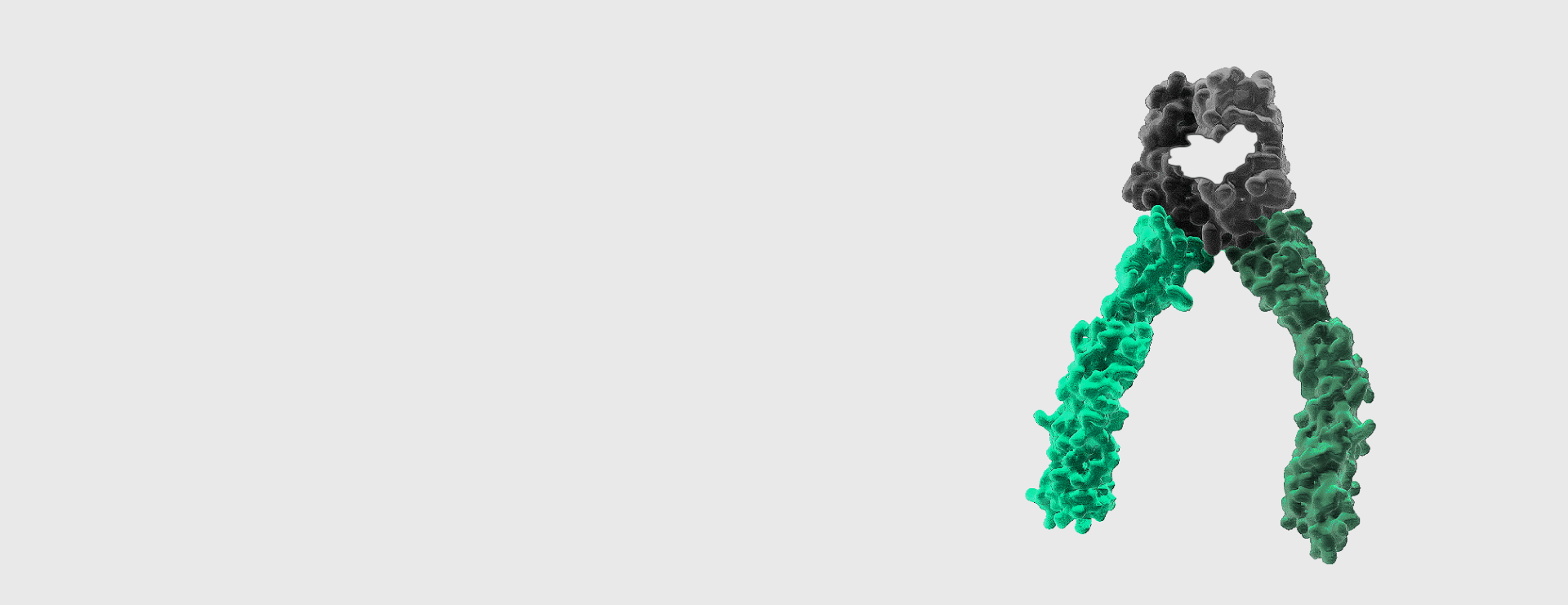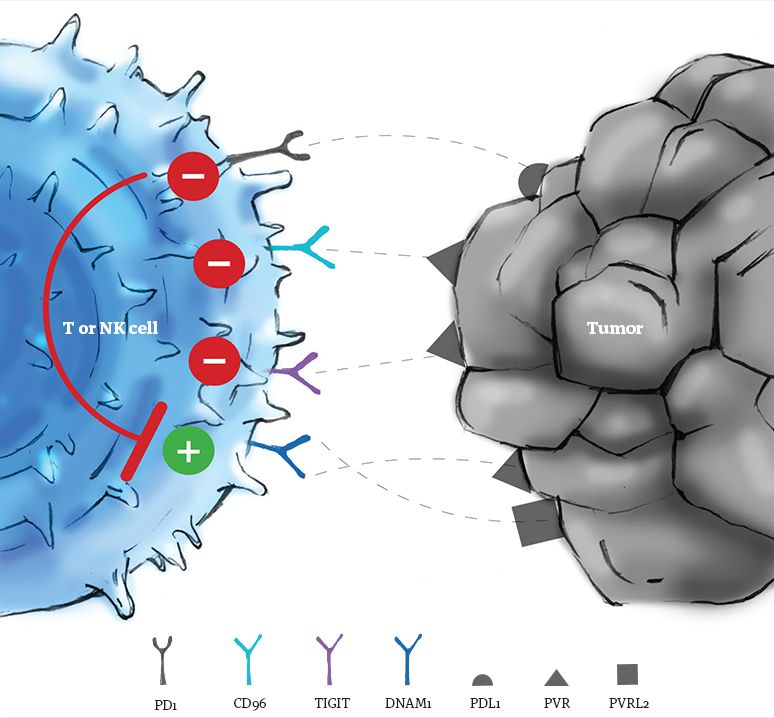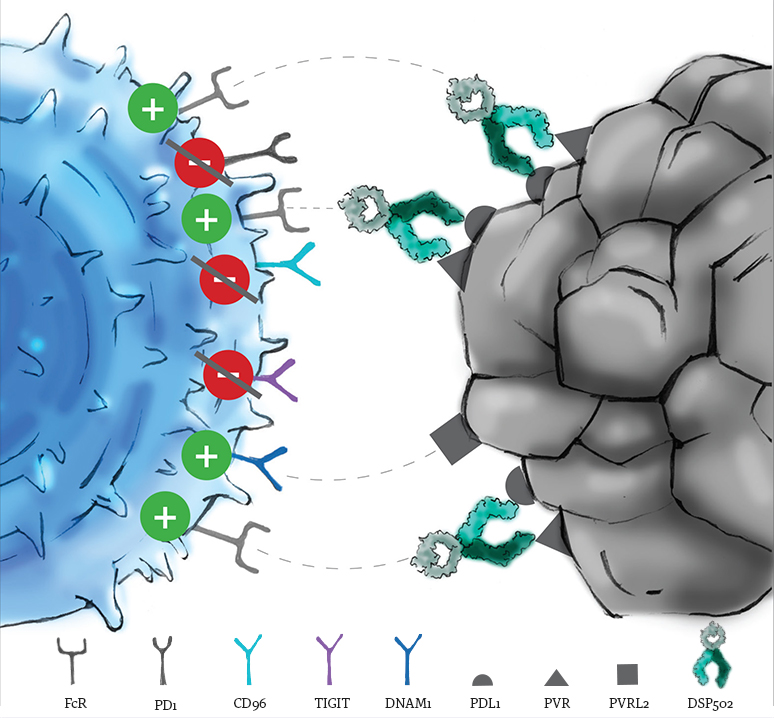

DSP-FC 502
DSP-FC 502
Synergistic PVR and
PD-L1 blockade
PD-L1 blockade
Synergistic PVR and
PD-L1 blockade
PD-L1 blockade
Novel functional configuration
DSP-FC 502 comprises dual checkpoint ligand domains (TIGIT and PD1), designed to synergistically enhance innate and adaptive anti-tumor immunity by simultaneously targeting the TIGIT pathway and blocking the PD1-PDL1 axis.
The TIGIT domain binds overexpressed PVR, preventing internalization of DNAM1, interrupting inhibitory signaling of TIGIT and CD96 and potentiates DNAM1 costimulatory signaling in activated T- and NK-cells. The PD1 domain binds PD-L1, unleashing effector T-cells through checkpoint inhibition.
DSP-FC 502 benefits from an “and gate” dependence – requiring concomitant binding of both PD-L1 and PVR, aimed at increasing specific binding in the TME and preventing off-target toxicity.
In parallel, the IgG1-Fc domain binds immune cells within the tumor microenvironment via Fc receptors, delivering an immune-activating signal that results in a a selective tumoricidal response.
The TIGIT domain binds overexpressed PVR, preventing internalization of DNAM1, interrupting inhibitory signaling of TIGIT and CD96 and potentiates DNAM1 costimulatory signaling in activated T- and NK-cells. The PD1 domain binds PD-L1, unleashing effector T-cells through checkpoint inhibition.
DSP-FC 502 benefits from an “and gate” dependence – requiring concomitant binding of both PD-L1 and PVR, aimed at increasing specific binding in the TME and preventing off-target toxicity.
In parallel, the IgG1-Fc domain binds immune cells within the tumor microenvironment via Fc receptors, delivering an immune-activating signal that results in a a selective tumoricidal response.


UNIQUE ADVANTAGES
Multiple inhibition of
checkpoint pathways

Activating innate and
adaptive immunity
Triggers ADCC-mediated tumor killing

Dual checkpoint
“And gate” dependency
THE SCIENCE OF DUAL CHECKPOINT BINDING
Independent research has established that elevated PVR expression on cancer cells can be predictive of non-responsiveness to PD1 blockade in lung cancer and melanoma. Prior clinical studies have also demonstrated that inhibition of TIGIT alone utilizing therapeutic monoclonal antibodies provided suboptimal anti-tumor activity. However, TIGIT inhibition combined with PD1 blockade produced encouraging results in lung cancer patients. It is believed that PD1 blockade leads to inactivation of DNAM1 costimulatory signaling by dephosphorylating the DNAM1 signaling motif and reducing its expression.
TIGIT, a member of the PVR (poliovirus receptor) family of Ig proteins, is an inhibitory receptor exclusively expressed on effector and regulatory T cells and NK cells. TIGIT is part of a complex molecular network containing four receptors (DNAM1, TIGIT, PVRIG and CD96) and two ligands (PVR and PVRL2).
This complex network containing activatory DNAM1 (CD226) and inhibitory TIGIT, PVRIG, CD96 receptors, modulates immune cell function upon binding to the shared ligands – PVR (CD155) and/or PVRL2 (CD112). TIGIT binds PVR and sharply reduces the effector function of T and NK cells by dampening DNAM1 co-stimulation.
PVR is a transmembrane glycoprotein from the Ig superfamily, expressed on monocytes, dendritic cells, fibroblasts and endothelial cells. PVR is overexpressed on cancer cells and other cells of the tumor microenvironment (TME). PVR overexpression facilitates tumor cell growth and migration and is correlated with tumor progression and unfavorable prognosis. High PVR expression is also associated with resistance to anti-PD-1 therapy. PVR negatively affects DNAM1 surface expression resulting in impaired anti-tumor activity of the effector lymphocytes. Besides sequestering DNAM1, PVR promotes immunosuppression through TIGIT, which is upregulated on activated NK and effector/regulatory T cells. TIGIT-PVR interaction down-regulates T and NK cell anti-tumor activity.
Pre-clinical studies have demonstrated that TIGIT blockade may protect against various solid and hematological cancers. Several monoclonal antibodies (mAbs) targeting TIGIT have been developed and clinical trials are ongoing. To date, TIGIT blockade for the treatment of patients with advanced solid malignancies has shown encouraging efficacy mainly when combined with anti-PD1/PD-L1 mAbs, but not as monotherapy.
This complex network containing activatory DNAM1 (CD226) and inhibitory TIGIT, PVRIG, CD96 receptors, modulates immune cell function upon binding to the shared ligands – PVR (CD155) and/or PVRL2 (CD112). TIGIT binds PVR and sharply reduces the effector function of T and NK cells by dampening DNAM1 co-stimulation.
PVR is a transmembrane glycoprotein from the Ig superfamily, expressed on monocytes, dendritic cells, fibroblasts and endothelial cells. PVR is overexpressed on cancer cells and other cells of the tumor microenvironment (TME). PVR overexpression facilitates tumor cell growth and migration and is correlated with tumor progression and unfavorable prognosis. High PVR expression is also associated with resistance to anti-PD-1 therapy. PVR negatively affects DNAM1 surface expression resulting in impaired anti-tumor activity of the effector lymphocytes. Besides sequestering DNAM1, PVR promotes immunosuppression through TIGIT, which is upregulated on activated NK and effector/regulatory T cells. TIGIT-PVR interaction down-regulates T and NK cell anti-tumor activity.
Pre-clinical studies have demonstrated that TIGIT blockade may protect against various solid and hematological cancers. Several monoclonal antibodies (mAbs) targeting TIGIT have been developed and clinical trials are ongoing. To date, TIGIT blockade for the treatment of patients with advanced solid malignancies has shown encouraging efficacy mainly when combined with anti-PD1/PD-L1 mAbs, but not as monotherapy.
PD-1 and PD-L1, members of the immune checkpoint proteins from the Ig superfamily, are inhibitors of both adaptive and innate immune responses. PD-L1 is commonly expressed on the surface of antigen presenting cells and tumor cells. PD-L1 specifically binds to its receptor, PD-1, expressed on the surface of activated T cells and reduces their anti-tumor activity.
The PD-1/PD-L1 interaction ensures that the immune system is activated only at the appropriate time to minimize potential development of chronic autoimmune inflammation. Cancer cells use the same mechanism to evade immune surveillance. Blockade of the PD1-PDL1 axis has introduced a paradigm shift in cancer therapy and led to objective clinical responses in advanced cancer patients.
The PD-1/PD-L1 interaction ensures that the immune system is activated only at the appropriate time to minimize potential development of chronic autoimmune inflammation. Cancer cells use the same mechanism to evade immune surveillance. Blockade of the PD1-PDL1 axis has introduced a paradigm shift in cancer therapy and led to objective clinical responses in advanced cancer patients.
Get in Touch
KAHR Dam HaMacbim St 28, POB 9 Modi'in Makabim-Re'ut 7178594, Israel T. +972.73.7969196 [email protected]